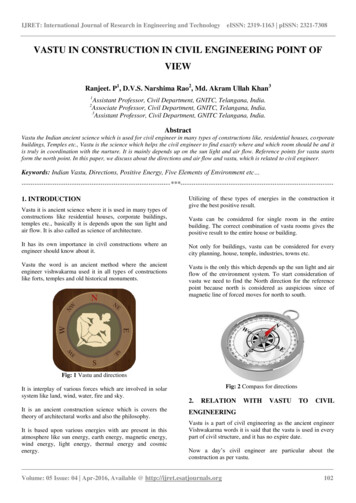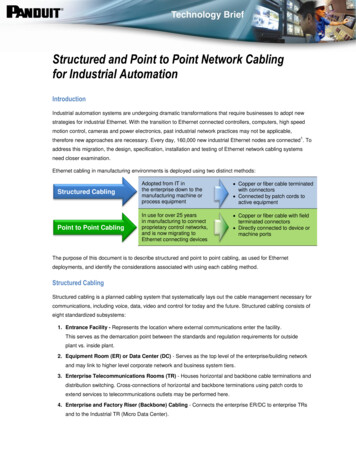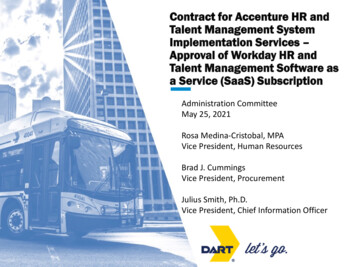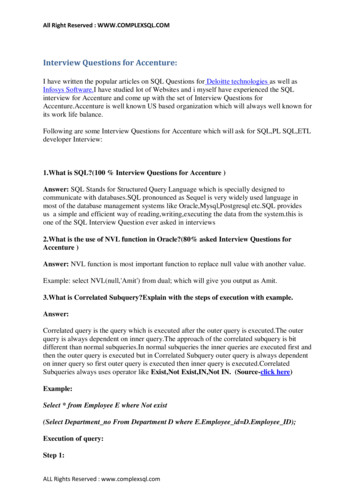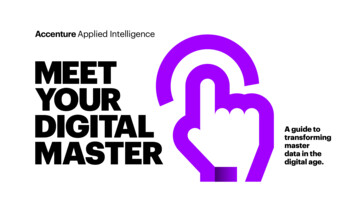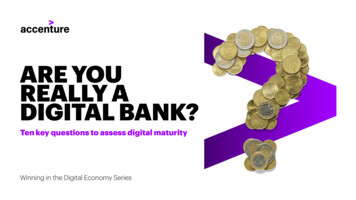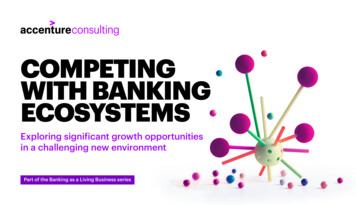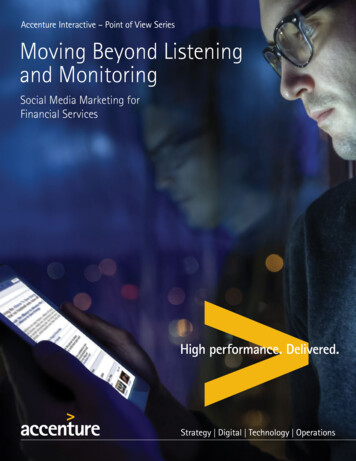
Transcription
Accenture Interactive – Point of View SeriesMoving Beyond Listeningand MonitoringSocial Media Marketing forFinancial Services
Don’t just listen; learn and earnSocial Media Marketingfor Financial ServicesToday, financial servicesconsumers have moved beyondjust using the Internet as aninformation-gathering tool,to using both the Internet andmobile channels for an interactive,even social, experience.Social networks are growing atpace; by 2017, the global socialnetwork audience is expectedto total 2.55 billion.1In the UK, the percentage of customerswilling to give personal information to theirbank online in exchange for better valueor tailored services more than doubledfrom 2012 to 2014.2 And recent Accentureconsumer research shows that nearly athird of consumers use information fromsocial media sites when evaluating retailbanking products and services. While still aminority, many consumers want companiesto get directly involved in contributing todiscussions on social media, and nearly onein four are more likely to do business with acompany that they know they can interactwith in a social media environment.3Many financial services firms have responded byusing social media to listen to their customersand monitor their brands. However, they arenot yet using it to generate tangible businessbenefits. With advances in optimization tools,analytics and software, social media is nowmuch more a science than an art. It can be avery effective means to build a community andengage with the consumer in a more personalway. By harnessing the power of analytics andintegrating social media insights holisticallyinto the company’s marketing strategy, financialservices firms can drive growth, increaseoperational efficiency and reduce risk.1 “Social Networking Reaches Nearly One in Four Around the World,” eMarketer Inc., June 18, 2013. Retrieved September,8th 2014 from: -Reaches-Nearly-One-Four-Around-World/10099762 “Winning the race for relevance with banking customers”, Accenture 2014, Retrieved September, 8th 2014 urvey.pdf3 “The Digital Customer: It’s Time to Play to Win”, Accenture Global Consumer Pulse Research 2013. Retrieved September,8th 2014 from: al-customer-play-to-win-summary.aspx
Social innovationLeading financial services companies are increasingly using socialmedia marketing with strong results. American Express pioneeredseveral successful online initiatives that monetized the uniquefeatures of social media, such as location check-ins for discountswith Foursquare (Sync, Explore, Save) and discounts throughFacebook (Link, Like, Love).4 These programs worked by linking theindividuals’ American Express cards to their Facebook account anddelivering deals and offers based on Facebook activity, pages thatwere liked and shared, as well as the activities of Facebook friends.With just one click, the discount was attached to the user’s account.When the related transaction occurred with the correspondingAmex card within a specific time period, a statement credit wasautomatically applied. The promotion offered customers anintegrated way to earn rewards for using their Amex card, promotingloyalty and affinity with the brand. What was the benefit to AmericanExpress? A positive response and greater sharing of content by usersdue to highly tailored offers – both leading indicators of greatercustomer satisfaction and retention.Social innovations getting results: Launching a competition to make consumer engagementmore robust Launching an innovative digital campaign allowing newcustomers to choose their relationship manager Launching a stock trading application to attract thenew class of retail investors Providing customers with a wide range of products, offers,and initiatives via social media Using “e-commerce offers” to promote the online branch Offering personal customer alerts and customer care Creating dedicated accounts for any customer segment ortopic to enable followers joining live discussions aroundseveral areas of interest.4 “American Express Launches “Link, Like, Love” on Facebook”, American Express, July 2011.Retrieved August, 28th 2014 /link.aspx
Getting real resultsWhile most financial services firms are using social media to some extent, the vast majorityis stopping short of using it to engage customers – leaving substantial business benefitsunrealized. Social media marketing is no longer about passively listening to customers orconducting stealth experiments. A successful social media program hinges on: Understanding the relevant social audience and the organization’s goals and limits Mapping customer needs to a social experience that the organization can deliver Enabling the organization with the right capabilities to execute.Financial services firms have the opportunity to build on their market presence, brand awarenessand marketing expertise to drive significant business impact through social media (Figure 1).Figure 1: Tangible Business Results from Social MediaDrive organicgrowthIncrease operatingefficiencyReduce risksIncrease customeracquisitionLower cost to sell/cost to serveManage brandreputationOptimize marketingspending/effortInnovate riskmanagement/fraudpreventionImprove crossselling/SoWIncrease customerretention 2014 Accenture. All rights reserved.
Driving organic growthSocial media offers new customer informationsuch as personal attitudes, hobbies and needsthat could help acquire customers and nurtureexisting relationships, both of which driveorganic growth. This new customer informationcan enhance customer intimacy and customerinsight and move marketing toward deliveringpersonalized sales and service experiences.An enriched customer profile can help identifysweet spots in existing segments, select microtargets and launch personalized cross sellingand acquisition campaigns.In this way financial services firms can gainactionable insight on customer needs (usingsuch techniques as interest graph analysisand activity feed analysis) and life eventsat an individual, friends and family level.They can also leverage marketing automationand campaign management platforms todeliver personal marketing campaigns.For example, they can identify individualcustomers through connections on LinkedIn,position personalized interest/hobby relatedoffers based on Facebook likes and directlyinitiate customer dialogues using Twitter.Gamification is another key tactic to enrichthe customer experience, as well as to designproducts whose properties evolve accordingto social sharing. And financial servicesfirms are able to design experiences withnetwork dynamics in mind. A significantpart of the buying decision process nowhappens in review and comparison sites,communities or crowd sourced contentservices. In this environment, financialservices firms can extend their sphereof influence through proactive analysis,outreach and relationship managementactivities, and by enticing loyal customersto spread their influence.Social In ActionIn 2013, Indian bank ICICI launched“Pockets by ICICI Bank”, an app allowingcustomers to access their accountsand conduct a wide variety of bankingtransactions directly from its Facebook page.This social media strategy targets the morethan 82 million Facebook users throughoutIndia, 40 percent of whom are under age 30.Since launching its Facebook page the bankhas amassed more than three million “likes”and continues to build out new “Pockets”capabilities to make banking simpler andeasier for its customers.Source: llows-customers-pay-friendssplit-expenses?utm source reference article
Increasing operating efficiencySocial media can be harnessed to “improvethe basics” including lowering cost to selland cost to serve and optimizing marketingspending. By seamlessly integrating currentcustomer service workflows with social mediacomponents, financial services companiesare already able to leverage the crowd effect,exploiting the potential of user-generatedcontent such as in Q&A platforms.Financial institutions can also employ aresource sharing approach, convergingdifferent media and channels. In this wayskilled customer service workers can provideservices through different channels achievinghigher efficiency at a lower cost.From a brand awareness perspective,traditional marketing techniques, such asword-of-mouth and member-get-member,might increase their power by leveraginggreater reach and resonance of the marketingmessage, where a single commercial “meme”could reach a huge audience instantly.The famous Oreo tweet during the XLVIISuperbowl “You can still dunk in the dark”generated more than 500 million impressionswith 0 dollars in media spending.5While the Oreo tweet is impressive in thereach and impact it achieved, these kinds ofsuccesses are opportunistic. Social now needsto be much more of a science, orchestrated toseek success without requiring a spontaneousmoment or event. In a data-centric way, socialcan methodically drive operating efficienciesand optimized spending.Social In ActionThe Barclaycard Ring MasterCard, offeredby global financial services provider BarclaysPLC, is the first credit card to be designedand built through crowdsourcing. The Ringcommunity platform allows communitymembers to share ideas with Barclaycard andto help each other on a variety of financialquestions. Customers are engaged in theproduct design and enhancement, buildingloyalty, peer-support and word of mouth.Combined with other voice of the customerinitiatives this program has decreasedcustomer complaints by 50%, and increasedcustomer retention by 25%, resulting in anannualized benefit of over 10 million.Source: “Barclaycard Ring”, Barclaycard, RetrievedSeptember 8th 2014 from: http://www.barclaycardring.com/“The Barclaycard Story”, Lithium. Retrieved September, 8th2014 from: s/barclaycardReducing risksA big component of the financial servicesbusiness is about sizing, anticipating andmanaging risks. For insurance companies,risk is a core component of the valuechain; for banks it is a long-term bet andfor capital markets it is a driver of higherreturns. Furthermore, Accenture’s consumerresearch showed that brand reputation andtrustworthiness are key satisfaction driversamong customers.65By identifying early signals and actingon (not just gathering) intelligence fromconsumer and business social data, socialmedia could help to dramatically innovatereputational risk management. Looking atthe customer within this broader networkof relationships would introduce newapproaches to help prevent fraud andbetter assess risk profiles.Banks are already starting to understand localbusinesses by analyzing bill payments, moneytransfers and evaluating the micro-marketfrom an economic standpoint to better assessdefault risks and capital requirements forspecific loans. Through social media marketersand risk managers will have an extendedview of customers within their network.“Dunking in the dark”, 360i, Retrieved August, 28th 2014 from: http://www.360i.com/work/oreo-super-bowl/6 “The Digital Customer: It’s Time to Play to Win”, Accenture Global Consumer Pulse Research 2013. Retrieved September,8th 2014 from: al-customer-play-to-win-summary.aspxSocial In ActionUBS, a leading global financial servicesprovider, observed that understanding whatis being published in social media is vital toeffective communications, risk managementand brand protection. Working with Accenture,UBS built a more functional social mediamonitoring capability delivered through globalstandardized services, scalable technologyand methodology. The service operates in fourdifferent languages utilizing native speakerswith industry backgrounds to eliminatemundane postings, spot irony and understandcontext. UBS gets a more comprehensive viewand may conduct campaign-related monitoringat short notice and at a relatively low fee.Through this new capability, UBS has a holisticperspective in the digital social world and mayfulfill important business objectives in the areaof reputation management and customer trust.Source: “UBS: Outsourcing Social Media Monitoring”,Accenture. Retrieved September, 8th 2014 ubs-social-media-monitoring.aspx
Making social payTo build the right social media marketing approach, companies haveto start by deeply understanding their social media readiness acrossall aspects of the organization, procedures, processes and technologies.In particular, the organization has to be aligned with the social mediamarketing strategy and have a group responsible for social media activities.Procedures have to be adapted to incorporate social media as apossible channel through which the prospect and customer caninteract with the organization. Specific processes need to be inplace in order to guide the execution across all customer-facingtouchpoints. The right technology must be available. Not onlyspecific social media marketing components, but also moretraditional components need to be social media “ready”.While every journey will be different, social media pioneers havefollowed four basic steps to improve the potential of social (Figure 2).
Figure 2: Steps to Harness Social MediaDefineExperimentExtendExpandDefine the socialmedia marketingstrategyExecute the socialmedia marketingfirst pilotAdd targetedoutcome segmentsand tacticsTransform socialmedia into a newgrowth engineDefining the social mediamarketing strategy beginswith identification of socialmedia marketing goals, andunderstanding the brand andproduct characteristics thatcan drive value in the socialmedia cont
Offering personal customer alerts and customer care Creating dedicated accounts for any customer segment or topic to enable followers joining live discussions around several areas of interest. 4 “American Express Launches “Link, Like, Love” on Facebook”, American Express, July 2011.


